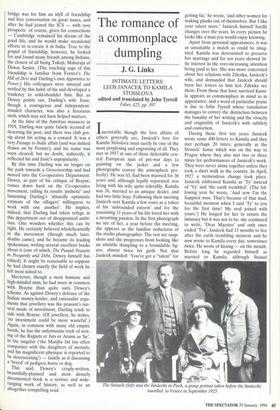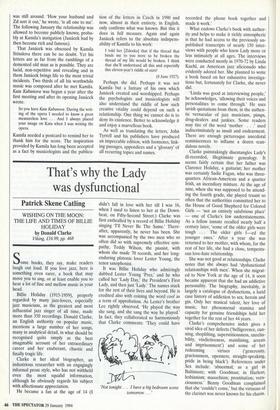The romance of a commonplace dumpling
J. G. Links
INTIMATE LETTERS: LEOS JANACEK TO KAMILA STOSSLOVA edited and translated by John Tyrrell Faber, £25, pp. 397 Inscrutable though the love affairs of others generally are, Janacek's love for Kamila Stosslova must surely be one of the most perplexing and engrossing of all. They met in 1917 at one of those delectable cen- tral European spas of pre-war days (a painting on the jacket and a few photographs convey the atmosphere per- fectly). He was 63, had been married for 36 years and, although legally separated, was living with his wife quite tolerably. Kamila was 26, married to an antique dealer, and had two little boys. Following their meeting Janacek sent Kamila a few roses as a token of his 'unbounded esteem' and for the remaining 11 years of his life loved her with a mounting passion. In the first photograph we see of her, a year before the meeting, she appears as the familiar seductress of the studio photographer. The rest are snap- shots and she progresses from looking like an amiable dumpling to a formidable fig- ure, almost twice his girth. Not that Janacek minded: 'You've got a "talent" for
getting fat,' he wrote, 'and other women for making planks out of themselves. But I like your talent more.' Janacek himself hardly changes over the years. In every picture he looks like a man you would enjoy knowing.
Apart from personal appearances, it was as unsuitable a match as could be imag- ined. Kamila was determined to preserve her marriage and for ten years showed lit- tle interest in the ever-increasing attention being paid to her. She was more concerned about her relations with Zdenka, Janacek's wife, and demanded that Janacek should burn her letters to him lest Zdenka see them. From those that have survived Kami- Ia appears as commonplace in mind as in appearance, and a word of particular praise is due to John Tyrrell whose translation manages to convey the distinction between the banality of her writing and the vivacity and originality of Janacek's with subtlety and conviction.
During those first ten years Janacek wrote some 400 letters to Kamila and they met perhaps 20 times, generally at the Stossels' home which was on the way to Prague where they also met two or three times for performances of Janacek's work. They were never alone together unless they took a short walk in the country. In April, 1927 a tremendous change took place. Janacek addressed Kamila as 'Ty' instead of 'Vy' and 'the earth trembled'. (The fol- lowing year he wrote, 'And now I'm the happiest man. That's because of that mad, beautiful moment when I said 'Ty' to you for the first time! My soul joined with yours.') He longed for her to return the intimacy but it was not to be: she continued to write, 'Dear Maestro' and only once ended 'rya'. Janacek had 15 months to live after the earth trembling moment and he now wrote to Kamila every day, sometimes twice. He wrote of kissing — on the mouth. Before long he regarded himself as married to Kamila, although Stossel The Stiissels (left) and the Jamiceks in Pisek, a group portrait taken before the Janaceks travelled to Venice in September 1925 was still around. 'How your husband and Zd sort it out,' he wrote, 'is all one to me'. The following January the relationship was allowed to become publicly known, proba- bly at Kamila's instigation (Janacek had by then become rich and famous).
That Janacek was obsessed by Kamila Stosslova there can be no doubt. Yet his letters are as far from the ramblings of a demented old man as is possible. They are lucid, non-repetitive and revealing and in them Janacek brings life to the most trivial incidents. Two thirds of all his worthwhile music was composed after he met Kamila. Kata Kabanova was begun a year after the first meeting and after its opening Janacek wrote: So you have Kata Kabanova. During the writ- ing of the opera I needed to know a great measureless love ... And I always placed your image on Kata when I was writing the opera.
Kamila needed a postcard to remind her to thank him for the score. The inspiration provided by Kamila has long been accepted as a fact by musicologists and the publica- tion of the letters in Czech in 1990 and now, almost in their entirety, in English, only confirms what was known. But this it does in full measure. Again and again Janacek refers to the absolute indispens- ability of Kamila to his work: I told her [Zdenka] that if the thread that binds me to you were to be broken the thread of my life would be broken. I think that she'll understand all this and especially this eleven-year's riddle of ours!
(8 June 1927).
Perhaps she did. Perhaps it was not Kamila but a fantasy of his own which Janacek created and worshipped. Perhaps the psychologists and musicologists will also understand the riddle of how such creative vitality could depend on such a relationship. One thing we cannot do is to deny its existence. Better to acknowledge it and enjoy a marvellous book.
As well as translating the letters, John Tyrrell and his publishers have produced an impeccable edition, with footnotes, link- ing passages, appendices and a 'glossary' of all recurring topics and names.



































































 Previous page
Previous page